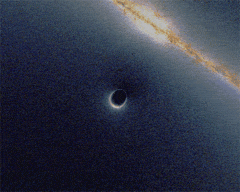
Lensing by a black hole. Animated simulation of gravitational lensing caused by a Schwarzschild black hole going past a background galaxy
 Black Holes are said to be like giant sucking vaccums. That even light can't escape it.
Black Holes are said to be like giant sucking vaccums. That even light can't escape it. IT is called a "Black" hole because even light can't escape it.
IT is called a "Black" hole because even light can't escape it. What is a black hole? According to Answers.com:
What is a black hole? According to Answers.com:A black hole is a theoretical entity predicted by the equations of general relativity. A black hole is formed when a star of sufficient mass undergoes gravitational collapse, with most or all of its mass compressed into a sufficiently small area of space, causing infinite spacetime curvature at that point (a "singularity"). Such a massive spacetime curvature allows nothing, not even light, to escape from the "event horizon," or border.
 But, How is the Black Hole made? WikiAnswers.com says:
But, How is the Black Hole made? WikiAnswers.com says:when a stars goes supernova some times all its matter collapses and compresses itself to create a black hole sucking in debris and stuff around it When a star is about 15 times bigger than our sun, (estimate) and super novas, it will turn into a nebula, which is a cloud of debris and matter that sucks itself back in due to gravity. The nebula will compress into a neutron star, which basically sits there and emits x-ray beams at near the speed of light. the neutron star is ridiculously dense (with a teaspoon weighing around 90,000kg), so it will eventually collapse on itself as well. this is what creates a black hole. the actual black hole is so dense in the center that anything that come too close will collapse into molecules and then be sucked in. the escape velocity of a black hole is higher than 186,000 miles per second, so light cannot even escape. Black holes sometimes come out of a dieing star, regularly an star 15-100 times the mass of our sun. When our sun dies, scientists KNOW that it will not produce a black hole but it will create a red giant and overtake the orbits of Mercury, Venus, and Earth. However some scientists believe that earth will not be destroyed by the sun but will take a new orbit, adjusting its orbit around the red giant. Although all life on earth will indefinitely be destroyed when this happens in about 5 billion years.
 OK so I am guessing everyone knows what a black hole is. If you don't know. Read above! But did you know there are also WHITE HOLES? They are kinda like black holes, well the complete oppisite. Instead of sucking they blow. While a black hole sucks up all light, the white hole blows everything.
OK so I am guessing everyone knows what a black hole is. If you don't know. Read above! But did you know there are also WHITE HOLES? They are kinda like black holes, well the complete oppisite. Instead of sucking they blow. While a black hole sucks up all light, the white hole blows everything.
No comments:
Post a Comment